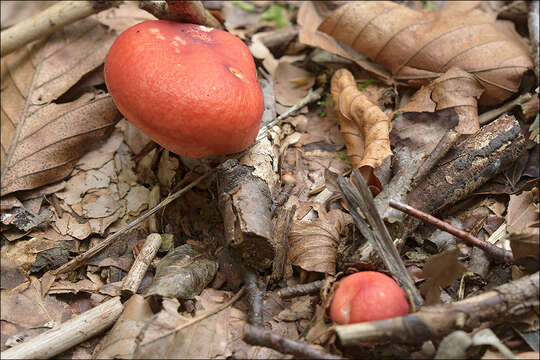Russula-silvestris_5

Description:
Russula silvestris (Singer) Reumaux, syn.: Russula emetica ssp. silvestris. (Singer) Reumaux, Russula emetica ssp. emeticella (Singer) Singer, Russula emetica var. silvestris Singer, Russula emeticella (Singer) Romagn,, Russula emeticella var. splendens Reumaux. EN: Sickener, Vomiting Russula, DE: Wald-Spei-Tubling, Kiefern-Spei-TublingFamily: RussulaceaeSection: Emeticinae Slo.: bljuvna golobica, mahov razliekDat.: Oct. 3. 2019Code: Bot_1260/2019_DSC8105Picture file names: from Russula-silvestris_raw_1 Russula-silvestris_raw_7.Lat.: 46.359572 Long.: 13.704544Habitat: mixed wood; Fagus sylvatica and Picea abies dominant trees; slightly inclined mountain slope, east aspect; calcareous, colluvial ground; in shade; fairly dry place; partly protected from direct rain by tree canopies; average precipitations ~ 3.000 mm/year, average temperature 7-9 deg C, elevation 555 m (1.820 feet), alpine phytogeographical region.Substratum: soil.Place: Lower Trenta valley, between villages Soa and Trenta; right bank of river Soa; near Skokar farmhouse, Trenta 2; East Julian Alps, Posoje, Slovenia EC.Comments: The number of species in the genus Russula is estimated to about 500 worldwide (Ref.: 2), many of which are not well characterized. Among them over 100 species have vividly red pileus. If we count only those, which have in addition a completely white stem, still about 80 species remain (Ref.: 1). To determine a find to species level is therefore not an easy task. This find almost certainly belongs to subgenus Russula (Pers.: Fr.) Bon, section Emeticinae, Melzer & Zvara (Ref.: 2). Spore are rather small and correspond to two species listed in Ref.:2: Russula emetica var. sylvestris = Russula silvestris (current name according to Index Fungorum) and Russula emetica var. grisescens. The last one is much bigger than this find and also has grayish stipe. Several other species have been also considered. Russula luteotacta was tentatively proposed (Ref. 1) since habit, habitat and particularly hut colors correspond well to this find (spot wise fading to pinkish and whitish with older specimens). However, gills are not broadly attached or +/- decurrent as they should be with R. luteotacta (Ref.:3). Also similar Russula mairei Sing. was considered. However, measured spores seems to be too broad (5.2-6.6 m for Russula mairei (Ref.3)). It also has slightly beige spore print and grows on damp soil, which doesn't fit to this find. We determined this find to Russula silvestris. This species is found primarily near conifers (particularly Pinus) but also in hardwood and mixed forests including near Fagus and Picea trees (Ref. 3). Nevertheless, the confidence of the determination is not high. Chemical tests and more microscopy would be needed for a more reliable resultGrowing solitary and scattered; 10 + pilei on an area of about two m2; pilei diameter 2.9 6 cm, hut cuticle peels to about 50% of pilei radius and above; gills bruise slightly yellowish after a longer time (several hours); stipe 2 -4.5 cm long and 0.8 -1.2 cm in diameter; smell almost none, taste very hot, instant and long lasting; SP abundant, white, oac909.Spores coarsely warty. Dimensions (7,4) 7,9 - 9,1 (10,1) (5,9) 6,4 - 7,2 (7,8) m; Q = (1,1) 1,2 - 1,3 (1,4); N = 30; Me = 8,5 6,9 m; Qe = 1,2. Olympus CH20, NEA 100x/1.25, magnification 1.000 x, oil (spores); fresh material, in water. AmScope MA500 digital camera.Herbarium: Index Herbariorum LJF @ Mycotheca and lichen herbarium of Slovenian Forestry Institute.Ref.: (1) Personal communication with Mr. Slavko erod, Mycological association Lisika, Maribor., www.gobe.si (2) G.J. Krieglsteiner (Hrsg.), Die Grosspilze Baden-Wrttembergs, Band 2., Ulmer (2000), p 555. (3) J. Breitenbach, F. Kraenzlin, Eds., Fungi of Switzerland, Vol.6. Verlag Mykologia (2005), p 198 and p168. (4) T.Volk, botit.botany.wisc.edu/toms_fungi/sep2004.html (accessed Oct.13. 2019) (5) wwww.123pilzsuche.de/daten/details/Speitaeubling.htm (accessed Nov. 2. 2019)
Included On The Following Pages:
- Life (creatures)
- Cellular (cellular organisms)
- Eukaryota (eukaryotes)
- Opisthokonta (opisthokonts)
- Nucletmycea
- Fungi (mushrooms, lichens, molds, yeasts and relatives)
- Dikarya
- Basidiomycota (basidiomycete fungi)
- Agaricomycetes (Mushroom-Forming Fungi)
- Russulales
- Russulaceae
- Russula (brittlegills)
- Russula silvestris
This image is not featured in any collections.
Source Information
- license
- cc-by-nc-sa
- copyright
- Amadej Trnkoczy
- photographer
- Amadej Trnkoczy
- original
- original media file
- visit source
- partner site
- Flickr Group
- ID


